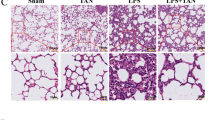Abstract
Corynoline, a bioactive compound isolated from Corydalis bungeana Turcz., has been known to have anti-inflammatory activity. However, its effects on the inflammation of the cardiovascular system have not been reported yet. The aim of this study was to investigate the anti-inflammatory effects of corynoline on lipopolysaccharide (LPS)-stimulated human umbilical vein endothelial cells (HUVECs). The results showed that LPS significantly increased the expression of VCAM-1 and ICAM-1. The production of cytokines TNF-α and IL-8 was also up-regulated by LPS. However, these increases were concentration-dependently suppressed by the treatment of corynoline. To investigate the anti-inflammatory mechanism of corynoline, we checked the activation of NF-κB and the expression of Nrf2. The results showed that LPS-induced NF-κB activation was suppressed by corynoline. The expression of Nrf2 and HO-1 was up-regulated by the treatment of corynoline. Knockdown of Nrf2 could reverse the anti-inflammatory effects of corynoline. In conclusion, the results indicated that corynoline exhibited anti-inflammatory activity by activating Nrf2.







Similar content being viewed by others
References
Ryan, S., C.T. Taylor, and W.T. McNicholas. 2009. Systemic inflammation: a key factor in the pathogenesis of cardiovascular complications in obstructive sleep apnoea syndrome? Thorax 64: 631–636.
Weinberg, C.B., and E. Bell. 1986. A blood vessel model constructed from collagen and cultured vascular cells. Science 231: 397–400.
Cai, H., and D.G. Harrison. 2000. Endothelial dysfunction in cardiovascular diseases: the role of oxidant stress. Circulation Research 87: 840–844.
Kofler, S., T. Nickel, and M. Weis. 2005. Role of cytokines in cardiovascular diseases: a focus on endothelial responses to inflammation. Clinical Science (London, England) 108: 205–213.
Mantovani, A., F. Bussolino, and M. Introna. 1997. Cytokine regulation of endothelial cell function: from molecular level to the bedside. Immunology Today 18: 231–240.
Shu, Y.Z. 1998. Recent natural products based drug development: a pharmaceutical industry perspective. Journal of Natural Products 61: 1053–1071.
Yang, C., C. Zhang, Z. Wang, Z. Tang, H. Kuang, A.N. Kong. 2016 Corynoline isolated from Corydalis bungeana Turcz. Exhibits anti-inflammatory effects via modulation of Nfr2 and MAPKs. Molecules 21.
Liu, Y., M. Song, G. Zhu, X. Xi, K. Li, C. Wu, and L. Huang. 2017. Corynoline attenuates LPS-induced acute lung injury in mice by activating Nrf2. International Immunopharmacology 48: 96–101.
Zhai, X.T., J.Q. Chen, C.H. Jiang, J. Song, D.Y. Li, H. Zhang, X.B. Jia, W. Tan, S.X. Wang, Y. Yang, and F.X. Zhu. 2016. Corydalis bungeana Turcz. attenuates LPS-induced inflammatory responses via the suppression of NF-kappaB signaling pathway in vitro and in vivo. Journal of Ethnopharmacology 194: 153–161.
Sallam, N., and I. Laher. 2016. Exercise modulates oxidative stress and inflammation in aging and cardiovascular diseases. Oxidative Medicine and Cellular Longevity 2016: 7239639.
Griffioen, A.W., and G. Molema. 2000. Angiogenesis: potentials for pharmacologic intervention in the treatment of cancer, cardiovascular diseases, and chronic inflammation. Pharmacological Reviews 52: 237–268.
Ikeoka, D., J.K. Mader, and T.R. Pieber. 2010. Adipose tissue, inflammation and cardiovascular disease. Revista da Associacao Medica Brasileira (1992) 56: 116–121.
Esposito, K., and D. Giugliano. 2006. Diet and inflammation: a link to metabolic and cardiovascular diseases. European Heart Journal 27: 15–20.
Loos, B.G., J. Craandijk, F.J. Hoek, P.M. Wertheim-van Dillen, and U. van der Velden. 2000. Elevation of systemic markers related to cardiovascular diseases in the peripheral blood of periodontitis patients. Journal of Periodontology 71: 1528–1534.
Matsumori, A., T. Yamada, H. Suzuki, Y. Matoba, and S. Sasayama. 1994. Increased circulating cytokines in patients with myocarditis and cardiomyopathy. British Heart Journal 72: 561–566.
Weber, C., L. Fraemohs, and E. Dejana. 2007. The role of junctional adhesion molecules in vascular inflammation. Nature Reviews. Immunology 7: 467–477.
Granger, D.N., and P. Kubes. 1994. The microcirculation and inflammation: modulation of leukocyte-endothelial cell adhesion. Journal of Leukocyte Biology 55: 662–675.
Li, H., M.I. Cybulsky, M.A. Gimbrone Jr., and P. Libby. 1993. An atherogenic diet rapidly induces VCAM-1, a cytokine-regulatable mononuclear leukocyte adhesion molecule, in rabbit aortic endothelium. Arteriosclerosis and Thrombosis 13: 197–204.
Collins, T., and M.I. Cybulsky. 2001. NF-kappaB: pivotal mediator or innocent bystander in atherogenesis? The Journal of Clinical Investigation 107: 255–264.
Silva-Palacios, A., M. Konigsberg, and C. Zazueta. 2016. Nrf2 signaling and redox homeostasis in the aging heart: a potential target to prevent cardiovascular diseases? Ageing Research Reviews 26: 81–95.
Li, J., T. Ichikawa, J.S. Janicki, and T. Cui. 2009. Targeting the Nrf2 pathway against cardiovascular disease. Expert Opinion on Therapeutic Targets 13: 785–794.
Cominacini, L., C. Mozzini, U. Garbin, A. Pasini, C. Stranieri, E. Solani, P. Vallerio, I.A. Tinelli, and A. Fratta Pasini. 2015. Endoplasmic reticulum stress and Nrf2 signaling in cardiovascular diseases. Free Radical Biology & Medicine 88: 233–242.
Author information
Authors and Affiliations
Corresponding author
Ethics declarations
Conflict of Interest
The authors declare that they have no conflict of interest.
Rights and permissions
About this article
Cite this article
Liu, B., Su, K., Wang, J. et al. Corynoline Exhibits Anti-inflammatory Effects in Lipopolysaccharide (LPS)-Stimulated Human Umbilical Vein Endothelial Cells through Activating Nrf2. Inflammation 41, 1640–1647 (2018). https://doi.org/10.1007/s10753-018-0807-6
Published:
Issue Date:
DOI: https://doi.org/10.1007/s10753-018-0807-6




